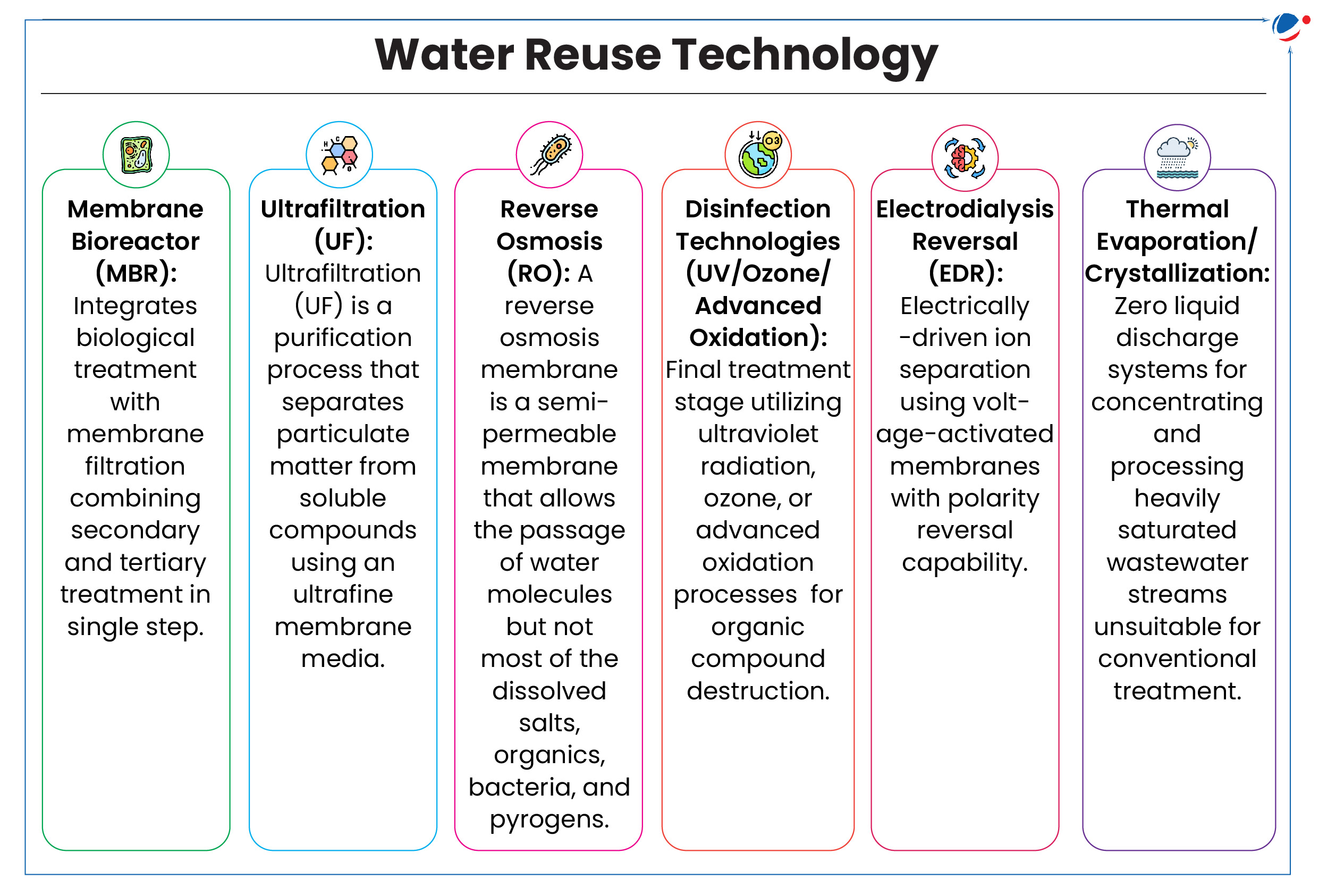Why in the News?
Recently, 'Jal hi Amrit' initiative has been launched under AMRUT 2.0 (Atal Mission for Rejuvenation and Urban Transformation 2.0) reforms during the 100 days agenda of the Government.
About Jal hi Amrit (JHA)
- Background: Building on the success of AMRUT 1.0, this second phase aims to create "Water-Secure Cities".
- JHA initiative aims:
- To incentivize States /UTs for efficient management of Sewage Treatment Plants (STPs), also termed Used Water Treatment Plants (UWTPs).
- To produce a continuous supply of high-quality treated water that meets environmental standards and supports sustainable water recycling practices
- To promote a circular economy of water by enabling reuse for various purposes like construction, industry, and irrigation.
- Purpose: To foster inter-city competition, build treatment facility capacities, and incentivize high-quality treated water discharge through systematic improvements.
- Strategy of rating-based incentives: UWTPs will be awarded Clean Water Credits through a Star Rating system. Incentives will be provided to urban local bodies (ULBs)/Parastatal agencies based on a comprehensive evaluation process.
- Rationale of JHA: Recycling and reusing treated used water are the cornerstones of ensuring sustainable management of water resources and reducing the stress on freshwater resources.
About AMRUT | ||
| AMRUT 1.0 | AMRUT 2.0 |
Launch Year | 2015 | 2021 |
Duration | Mission period from 2015-2020 | Mission period from 2021-2026 (5 years) |
Coverage | 500 cities and towns | All statutory towns in the country |
Focus Areas | Water supply, sewerage and septage management, storm water drainage, green spaces and parks, non-motorized urban transport | Universal coverage of water supply through functional taps to all households in all the statutory towns in the country, coverage of sewerage/ septage management in 500 cities. |
About Water Recycling & Reuse
- Definition: Water reuse (also commonly known as water recycling) reclaims water from a variety of sources then treats and reuses it for beneficial purposes.
- Sources of water for potential reuse: Municipal wastewater, industry process and cooling water, stormwater, agriculture runoff and return flows, etc.
Benefits of Water Recycling & Reuse
- Environmental benefits
- Water recycling decreases diversion of freshwater from sensitive ecosystems thereby prevents deterioration of water quality and ecosystem health.
- Saves energy otherwise required to extract or transport freshwater to the area. E.g., Reusing treated wastewater in irrigation reduces GHG emissions.
- Recharges groundwater, avoiding freshwater resource degradation and salinization. E.g., Treated water in Bengaluru is used to recharge shallow aquifers through natural percolation by filling lakes.
- Recycled water may be used to create or enhance Wetlands and Riparian (Stream) habitats.
- Socio-economic benefits
- Increases water availability for potentially water stressed or arid areas.
- Provides an easily accessible water source to economic sectors such as industry (e.g., In Karnataka, industrial estates within 30 km. of STPs are mandated to prioritise treated water) and agriculture (e.g., Haryana's Kurukshetra repurposes treated water for agriculture use).
- Improves the quality of agriculture through use of valuable nutrients extracted from the wastewater.
- E.g., carbon, nitrogen, phosphorous rich waste water.

Challenges of Water Recycling & Reuse
- Treating water to a precise specification: Industrial wastewater requires thorough treatment to remove oils, salts, solids and minerals before reuse.
- Plant requires significant investment: Water recycling systems are inherently expensive because they are high-tech and expensive to design and produce.
- Membrane fouling and maintenance challenges: Filtration membranes suffer efficiency loss due to fouling, requiring regular cleaning or costly replacement to maintain optimal performance.
- Water recycling is energy-intensive: The lower the quality of the water, and the more intensive the treatment, the more energy is needed to power the recycling process.
- Absence of guidelines: Sector-specific requirements for treated water reuse vary widely, as each sector has distinct standards for processed water quality—ranging from basic biological treatment to advanced purification methods like reverse osmosis.
- Stigma: Socio-cultural barriers often prevent the acceptance of recycled water on accusations of being 'toilet-to-tap'.
India and Water Recycling & Reuse
|
Way Forward to tackle challenges to Water Recycling & Reuse
- Setting up water reuse benchmarks for industries: By using fit-for-purpose standards to promote wastewater reuse and resource recovery while maintaining product quality standards.
- Incentivising the ecosystem: Government policies should offer incentives for industrial, academic, and research institutions conducting R&D in water treatment technologies and efficiency practices.
- Subsidize dual plumbing systems and offer property tax rebates to encourage residential areas to use treated water for non-potable applications.
- Implement tiered volumetric pricing structure: E.g., higher rates for non-recycled water, incentivizing municipalities and housing societies to adopt recycled water alternatives.
- Facilitate PPPs: By combining government financial support with private sector technical expertise to develop and maintain wastewater treatment infrastructure.
- Implement tradable water-use credits system: Based on treated wastewater usage, following World Bank Group's framework for wastewater reuse certificates.







